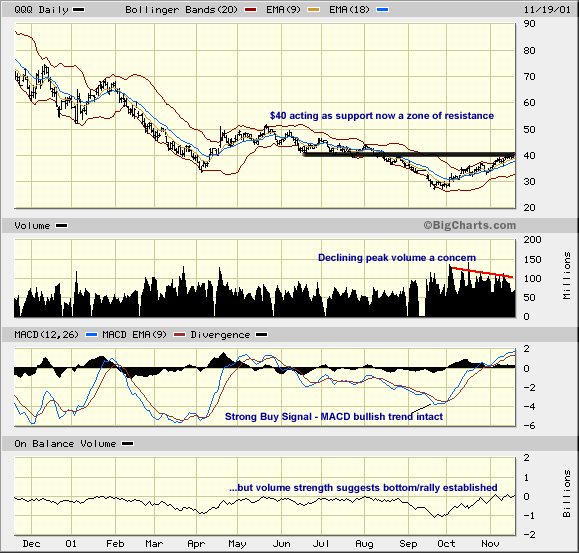The
Return of the Bull?
Written
on November 19th 2001 by Chris Lau
Economic Factors
The key ingredients for a sustainable stock market recovery are
here now. First, interest rates are at the lowest levels in several
decades. Second, the US government are working on earmarking billions
of dollars as a fiscal stimulus to the economy. Third, tax cuts
made in the summer have yet to filter into the economy. Fourth,
bonds (2 year term) collapsed on November 16 and on the same day,
fifth, oil prices are now $18/barrel. Conversely, job cuts continued
to increase, with the unemployment rate now at 5.4% in the U.S.(the
highest in 19 years).
The real question is:
are positives of the aforementioned economic factors adequate
to sustain the current rally? The answer lies the affect of the
unemployment rate on the economy. After all, the consumer was
the fuel for the bull market in the 1990's, and there is no reason
why it will not play a significant factor in the next bull market.
Thus lower oil prices, lower taxes and higher government spending
are factors that will stimulate spending consumer.
A
Rally in Review
|
 The
September terrorist attack was one of the worst non-war
event of our time, but from a financial viewpoint, served
to bring a great deal of negativity in the markets. The
chart above is the activity of the QQQ's (an exchange-traded
fund that mimics the level of the Nasdaq). The ensuing rally
in early October continues, but is headed towards a zone
of resistance, currently in the $40-$42.50 range (based
on moving averages). A breakout on strong volume above $44.50
would suggest the rally will continue well into the 2002.
However, every sell-off occurring at the resistance levels
increases the likelihood of a retest at $30. The
September terrorist attack was one of the worst non-war
event of our time, but from a financial viewpoint, served
to bring a great deal of negativity in the markets. The
chart above is the activity of the QQQ's (an exchange-traded
fund that mimics the level of the Nasdaq). The ensuing rally
in early October continues, but is headed towards a zone
of resistance, currently in the $40-$42.50 range (based
on moving averages). A breakout on strong volume above $44.50
would suggest the rally will continue well into the 2002.
However, every sell-off occurring at the resistance levels
increases the likelihood of a retest at $30.
Since the Dow
Jones Industrial Average is remarkably similar in pattern
(chart not shown) we will limit the analysis to the Nasdaq
index.
Chart
source: www.bigcharts.com on 19/11/2001
|
Stocks
Wish List
With many stocks reaching
astronomical returns over the past month (from a percentage basis),
investors still on the side-lines with lots of cash are probably
itching to put money back into the markets. Keep the rally in
perspective!
Telecom Gear Makers:
Let us take
Nortel as an example.
The stock rallied 79% from its low, but the gain represents only
a 44% recovery (and an 8% recovery from its 52 week high). Looking
at the chart (not shown), the rally is not surprising as trading
served to relieve oversold conditions. The key now from a technical
perspective is watching for the support levels (at the moving
averages) to hold. More importantly, Nortel needs to secure more
contracts in 2002 to justify its rally.
Telecommunication
Providers:
Has anyone noticed (in Canada) that the great big telcos
are able to raise high-speed internet access fees? Both Rogers
and Bell Canada have increased fees by about 10%. Since
the key ingredient to long-term investment success begins with
examining stable and growing cash flows, BCE and Rogers may prove
to be worthwhile investments. On the other hand, the "convergence"
strategy (and massive purchase of media companies) for these companies
may continue to weigh down BCE and Rogers in the short-term.
Software:
Even the leading software companies appear to have made huge
"recoveries" from recent lows. Siebel Systems
(+88%), Intuit (+76%), PeopleSoft (+119%). Of the
mentioned companies, I think Intuit will be able to hold on to
its gains, as the rise was slow and steady (each low was higher
than the previous low). Although companies like Siebel are great
companies, they are not great stocks at this time - long-term
trends remain negative, and the stock is still very expensive.
|

